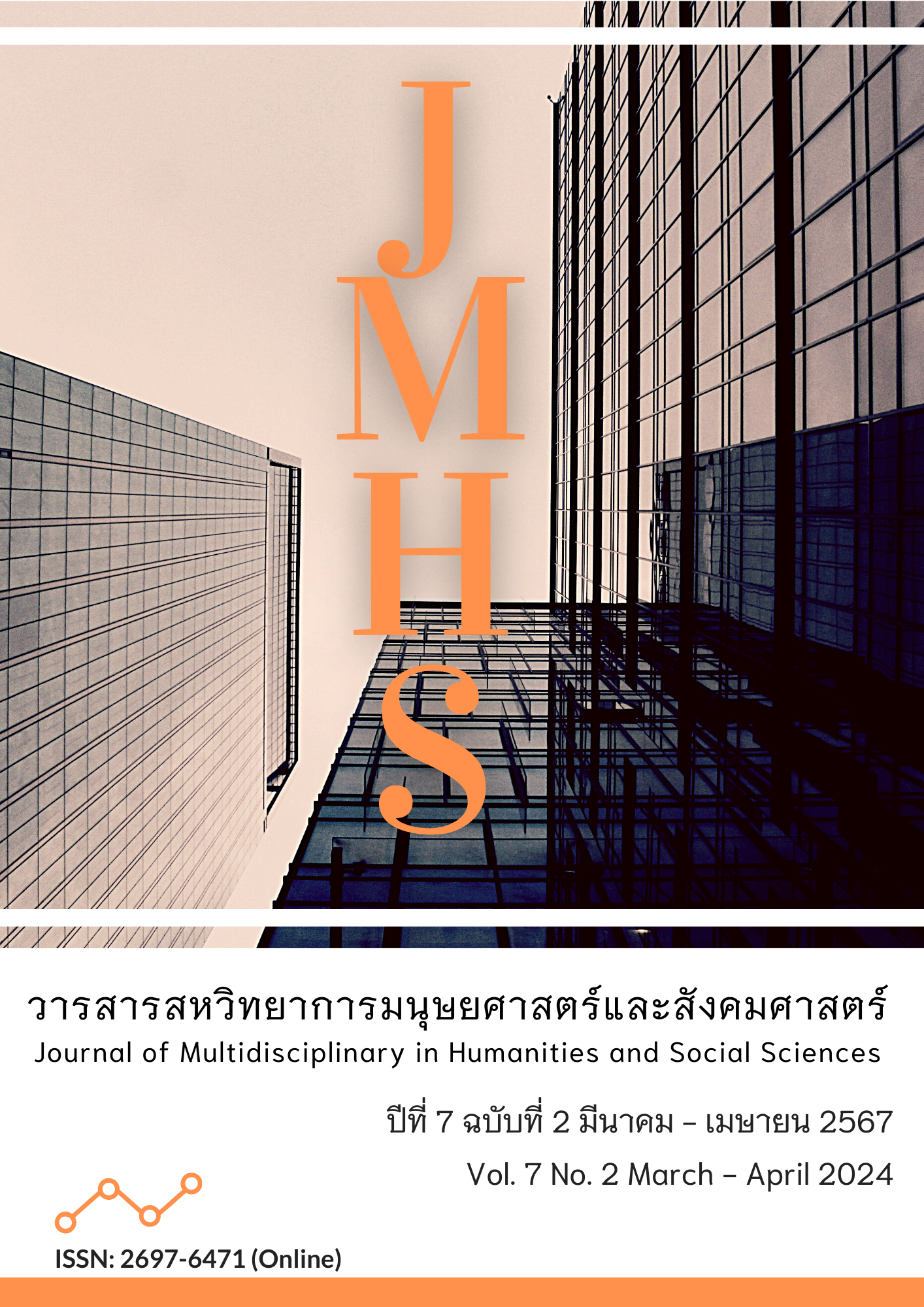มิติทุนวัฒนธรรมบนฐานการสร้างสรรค์ทางปัญญาในวัฒนธรรมดนตรี สู่การเสริมสร้างศักยภาพชุมชนที่ยั่งยืน
Main Article Content
บทคัดย่อ
วัฒนธรรมดนตรีมีบทบาทในการสะท้อนสังคมที่ทำให้เกิดค่านิยมและความเชื่อทางผลงานดนตรี การวิจัยนี้มีวัตถุประสงค์เพื่อศึกษามิติทุนวัฒนธรรมบนฐานการสร้างสรรค์ทางปัญญาในวัฒนธรรมดนตรีสู่การเสริมสร้างศักยภาพชุมชนที่ยั่งยืน โดยการวิจัยเชิงคุณภาพจากการสังเคราะห์เอกสาร และการแลกเปลี่ยนเรียนรู้แบบมีส่วนร่วมกับผู้รู้ทางวัฒนธรรมดนตรี จำนวน 10 คน ของการดำเนินการวิจัย
ผลการศึกษาพบว่า มิติทุนวัฒนธรรมบนฐานการสร้างสรรค์ทางปัญญาในวัฒนธรรมดนตรี ทั้งด้านดนตรีวิทยา ปรัชญาดนตรี และต้นทุนจินตนาการกับการออกแบบงานวิชาการดนตรีที่หลากหลาย ทั้งนี้ องค์ความรู้เป็นประโยชน์ต่อการศึกษาเกี่ยวกับดนตรี กวี และศิลป์ในการสร้างสรรค์นวัตกรรมทางปัญญาแห่งชุมชนต้นแม่น้ำเจ้าพระยา โดยผ่านองค์ความรู้และภูมิปัญญา กระบวนการเรียนรู้ ความสามารถทางความคิดเชิงสร้างสรรค์สู่ศักยภาพชุมชนที่ยั่งยืน และต่อยอดการพัฒนาทุนวัฒนธรรมที่มีคุณค่ามากยิ่งขึ้น ตลอดจนการสร้างมูลค่าที่จะส่งผลประโยชน์ต่อท้องถิ่นอย่างมีประสิทธิภาพ
Article Details

อนุญาตภายใต้เงื่อนไข Creative Commons Attribution-NonCommercial-NoDerivatives 4.0 International License.
ทัศนะและความคิดเห็นที่ปรากฏในวารสาร ถือเป็นความรับผิดชอบของผู้เขียนบทความนั้น และไม่ถือเป็นทัศนะและความรับผิดชอบของกองบรรณาธิการ
เอกสารอ้างอิง
ฉัตรทิพย์ นาถสุภา และ พรพิไล เลิศวิชา. (2551). วัฒนธรรมชุมชน. (พิมพ์ครั้งที่ 2). กรุงเทพฯ: เดือนตุลาการพิมพ์.
ชัยประนิน วิสุทธิผล. (2554). คุณค่าของเอเชีย เทรนด์ใหม่ที่โลกกำลังเดินตาม ทำไหมต้องเศรษฐกิจสร้างสรรค์. กรุงเทพฯ: ศูนย์สร้างสรรค์และออกแบบ.
ดนัย นิลสกุล และ นพดล ตั้งสกุล. (2558). ปัจจัยที่ส่งผลต่อสำนึกในถิ่นที่ในย่านการค้าเก่าเมืองอุบลราชธานี. วารสารสิ่งแวดล้อมสรรค์สร้างวินิจฉัย, 14(1), 44-57. สืบค้นจาก https://so01.tci-thaijo.org/index.php/arch-kku/article/view/43977
ดิเรก ปัทมสิริวัฒน์. (2551). ทุนทางวัฒนธรรมและภูมิปัญญากับการสร้างสรรค์คุณค่า. กรุงเทพฯ: สำนักงานคณะกรรมการพัฒนาเศรษฐกิจและสังคมแห่งชาติ.
ทวีศักดิ์ สาสงเคราะห์. (2554). เชาวน์ปัญญากับการสร้างสรรค์ภูมิปัญญาพื้นบ้าน. วารสารสถาบันวัฒนธรรมและศิลปะ, 13(1), 27-30. สืบค้นจาก https://so02.tci-thaijo.org/index.php/jica/article/view/2490
บำรุง บุญปัญญา. (2549). วัฒนธรรมชุมชนกับการพัฒนาที่ยั่งยืน. กรุงเทพฯ: สถาบันพัฒนาองค์กรชุมชน.
ระวิวรรณ โอฬารรัตน์มณี. (2552). สถาปัตยกรรมพื้นถิ่น: การศึกษา วิจัย และการปฏิบัติวิชาชีพสถาปัตยกรรม. วารสารวิชาการคณะสถาปัตยกรรมศาสตร์ สถาบันเทคโนโลยีพระจอมเกล้าเจ้าคุณทหารลาดกระบัง, 8(20), 56-66. สืบค้นจาก https://so04.tci-thaijo.org/index.php/archkmitl/article/view/4219
รังสรรค์ ธนะพรพันธ์. (2556). ทุนวัฒนธรรมในระบบทุนนิยมโลก. กรุงเทพฯ: สำนักพิมพ์มติชน.
วีระวุฒิ วัจนะพุกกะ และ อาทิตยา อรุณศรีโสภณ. (2552). ชุมชนแห่งนวัตกรรมและความคิดสร้างสรรค์. วารสารนักบริหาร, 30(3), 25-30.
ศุภวุฒิ สายเชื้อ. (2554). ประเทศไทยกับเศรษฐกิจสร้างสรรค์. กรุงเทพฯ: ศูนย์สร้างสรรค์และออกแบบ.
อมรา พงศาพิชญ์. (2555). ความหลากหลายทางวัฒนธรรม (กระบวนทัศน์และบทบาทในประชาคม). (พิมพ์ครั้งที่ 4). กรุงเทพฯ: โรงพิมพ์แห่งจุฬาลงกรณ์มหาวิทยาลัย.
เอี่ยม ทองดี. (2558). ทุนทางวัฒนธรรมชุมชน. วารสารวัฒนธรรมปริทรรศน์, 2(3), 16-29.
Bourdier, P. (2007). Outline of a Theory of Practice. Cambridge: Cambridge University Press.
Gibbons, M., Limoges, C., Nowontny, H., Schwartzman, S., Scott, P., & Trow, M. (1994). The New Production of Knowledge: The Dynamics of Science and Research in Contemporary Societies. London: SAGE Publications.
Habermas, J. (1987). The Theory of Communicative Action: Reason and The Rationalization of Society. Boston: Beacon Press.
Hoebel, E. A. (2010). Anthropology: The Study of Man. (3rd ed.). New York: McGraw-Hill.
Kaemmer, J. E. (1993). Music in Human Life Anthropological Perspectives on Music. Texas: University of Texas Press.


